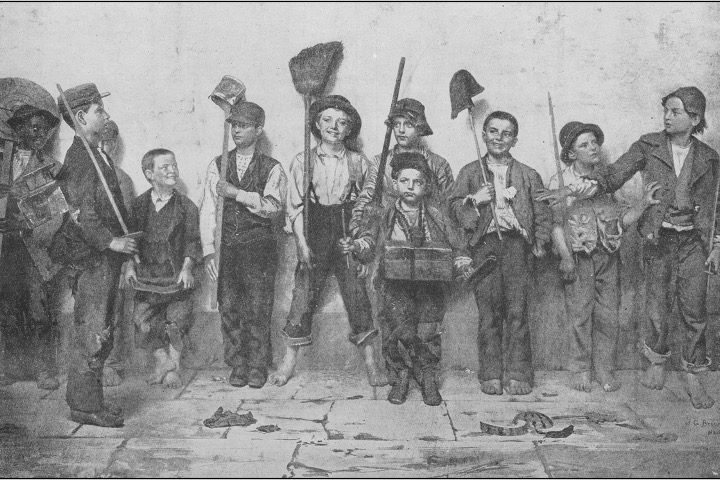
The youngest officer to command a vessel in U.S. naval history, it may shock most to learn, was 12-year-old David Farragut, who served as a prize master in 1812. Such a reality certainly is incongruent with our age, in which 15-year-olds wile away hours playing video games and youth irresponsibility is rife. Mankind’s norm has been for kids to assume adult roles early, however, with the idealization of childhood being a modern phenomenon. But is this “Cult of Childhood,” as one writer put it, actually hurting children? And if “work ennobles man,” as the saying goes, can it also ennoble a man-child?
The left-wing Nation’s Steve Fraser apparently doesn’t think so, and he claims that loosening teen labor laws is partially responsible for a situation he frames in a title thus: “Child Labor in America Is Back—and It’s As Chilling as Ever.” Yet what’s perhaps more chilling is media malpractice that, in Fraser’s case, takes the form of conflating perhaps prudent labor-law reform with the illegal exploitation of migrant minors — and then blaming it all on “capitalism.”
Fraser devotes much ink to discussing the late-19th and early-20th century exploitation of child labor, presenting lines such as, “Between 1890 and 1910, 18 percent of all children between the ages of 10 and 15, about 2 million young people, worked, often 12 hours a day, six days a week.” Though not revelatory, it’s interesting enough and no doubt largely true, though it’s hard trusting Fraser on specifics. After all, he also writes that today, “roofers in Florida and Tennessee can now be as young as 12.”
Incredible, huh? Except that Fraser provides no link to a source. I ran down the story, though, and found no evidence of any Fla. or Tenn. law allowing such. Apparently, the claim comes from a February New York Times article about exploited migrant labor. The Times never asserted that the roofer roles were lawful; rather, the illegal-alien kids were a small part of a “shadow work force,” the paper wrote.
So Fraser either got sloppy or, worse still, aimed to demonize the Left’s now-least-favorite governor, Ron DeSantis. Mission accomplished, too: Responding to Fraser’s piece, one commenter hissed that this was to be expected of Florida’s chief executive.
Fraser also mentions, among other things, an Iowa law allowing 16-year-olds to “take jobs in roofing, construction, excavation, and demolition and … operate power-driven machinery” (but neglects to point out that, according to his source, this requires state-agency “approval”). Of course, with agriculture being big in Iowa and farm boys often having to use “power-driven machinery,” is this surprising?
Returning to illegals, Fraser cites numerous examples of their exploitation, such as how, allegedly, American garment “factories and auto parts manufacturers (supplying Ford and General Motors) employ immigrant kids, some for 12-hour days.” The problem, however, is that virtually no one supports this — except for, tacitly, Fraser and his fellow travelers.
That is, this problem is easily solved by securing the border and enforcing immigration law. Yet leftists adamantly oppose this because, while they complain about the “greed” of illegal labor’s exploiters, they facilitate it due to their greed for power (importing new supporters).
Fraser also complains that many states have “legalized subminimum wages for youths.” Yet this is actually a good policy. Why? Just as when minimum wages were first introduced to protect white workers from black laborers who were willing to work more cheaply, they today have a similar effect: They price lower-skilled and/or more inexperienced workers, who tend to be inordinately young (and black), out of the market. In other words, if an employer must pay $15 an hour (as in N.Y.) and can for that wage hire a 22-year-old with some college and experience or a 16-year-old lacking such, he’ll almost invariably choose the former. Thus do minimum-wage laws make it hard for teens to get their foot in the door, develop practical skills, and build resumés.
But this isn’t the only thing Fraser gets backward. In fact, he does something common among moderns: He provides history but not historical perspective.
Fraser opens his piece citing an elderly Indian chief who, upon visiting NYC in 1906, was surprised to see “little children working.” Yet Fraser’s implications ignore that American Indian kids worked, too — only, their work was different because they were hunter-gatherers.
For instance, the National Park Service points out that Sioux boys would start hunting bison at age 10. What would today’s bubble-wrap safety police have to say about a prepubescent kid helping hunt an 1,800-pound beast with just a bow and arrow?
The bottom line is that children always worked, whether it was tribal kids hunting and gathering, agrarian-society boys helping dad work the fields while their sisters aided mom, or lads becoming tender-aged apprentices in a trade or heading off to sea. It’s not unusual; what’s unusual is fancying it unusual.
Of course, commonality doesn’t prove morality, and we certainly don’t want kids worked mercilessly in sweatshops. Yet there’s a lot of real estate between that and frittering away one’s youth engrossed in games and social media while pondering if you should change your “gender” for the second time this month. Work does build character, too, right?
Not according to Fraser. He cites as bizarrely antiquated thinking a 1575 Elizabethan law providing “public money to employ children as ‘a prophylactic against vagabonds and paupers,’” before writing that “such claims that working at an early age warded off the social dangers of ‘idleness and degeneracy’ remained a fixture of elite ideology well into the modern era. Indeed, it evidently remains so today.” What’s bizarre, however, is finding this bizarre.
By definition, “working” wards off “idleness” because it’s the precise opposite of it: When working you’re not idle. Moreover, has it escaped Fraser’s notice that kids with nothing productive to do tend to cause trouble? Does he not know that in rough neighborhoods such youths are prime candidates for gangs?
The sayings “An idle mind is the Devil’s workshop” and “Busy hands are happy hands” inform of this peril. Because children are people, they operate by the principles governing people, one of which is that meaning in life is a prerequisite for happiness. Productive work — in a balanced life involving education and recreation as well — can help provide that meaning.
And the character this can build may prevent them from growing up and complaining, as Fraser does, that the “estimated 152 million children at work worldwide” are “a reminder of how deeply retrogressive capitalism [read: economic freedom] has once again become.”
Yet no small number of those 152 million laboring kids apparently are in “communist” (fascist, really) China, according to The Borgen Project. Also note that it’s only market economies that birthed the wealth that freed man — and his children — from the grinding poverty and backbreaking labor that had, for so long, typified his existence.
For those interested, the fairly short video below presents truly dangerous jobs children once performed — before market-born wealth transformed civilization.



